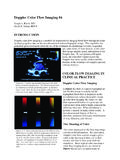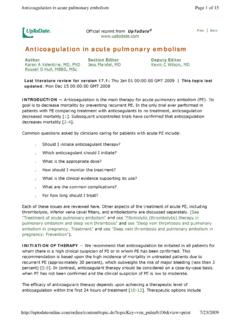Transcription of Shunt Detection and Quantification - Cardioland
1 9 Shunt Detection and QuantificationWilliam GrossmanUniversity of California, San Francisco, School of Medicine; Division of Cardiology, University of California, San Francisco Medical Center, San Francisco, California 94143 Detection , localization, and Quantification of intracardiac shunts are an integral* part of the hemodynamic evaluation of patients with congenital heart disease. In most cases, an intracardiac Shunt is suspected on the basis of the clinical evaluation of the patient before catheterization. There are several circumstances, however, in which data obtained at catheterization should alert the cardiologist to look for a Shunt that had not been suspected arterial desaturation should immediately raise the suspicion of a right-to-left intracardiac Shunt , which may then be assessed by the methods to be discussed.
2 Most commonly, arterial desaturation ( , arterial blood oxygen saturation under 95%) detected at the time of cardiac catheterization represents alveolar hypoventilation. The causes for this alveolar hypoventilation and its associated physiologic right-to-left Shunt include (a) excessive sedation from the premedication, (b) chronic obstructive lung disease or other pulmonary parenchymal disease, and (c) pulmonary congestion/edema secondary to the patient's cardiac disease. Alveolar hypoventilation associated with each of these problems is exacerbated by the supine position of the patient during the catheterization procedure. Helping the patient to assume a more upright posture (head-up tilt, or propping the patient up with a large wedge if tilt mechanism is not available) and encouraging the patient to take deep breaths and to cough will correct or substantially ameliorate arterial hypoxemia in most cases.
3 If arterial desaturation persists, oxygen should be administered by face mask for both therapeutic and diagnostic purposes. If full arterial blood oxygen saturation cannot be achieved by face-mask administration of oxygen (it is best in this regard to use a rebreathing mask that fits snugly), a right-to-left Shunt is presumed to be present, and its anatomic site and magnitude should be determined using the methods described later in this , when the oxygen content of blood in the pulmonary artery is unexpectedly high ( , if the pulmonary artery [PA] blood oxygen saturation is above 80%), the possibility of a left-to-right intracardiac Shunt should be considered. It is for these two reasons that arterial and pulmonary artery saturation should be measured routinely cardiac the data obtained at cardiac catheterization do not confirm the presence of a suspected lesion, one should consider the presence of an intracardiac Shunt .
4 For example, if left ventricular cineangiography fails to reveal mitral regurgitation in a patient in whom this was judged to be the cause of a systolic murmur, it is prudent to look for evidence of a ventricular septal defect (VSD) with left-to-right shunting. Detection OF LEFT-TO-RIGHT INTRACARDIAC SHUNTSMany different techniques are available for the Detection , localization, and Quantification of left-to-right intracardiac shunts. The techniques vary in their sensitivity, in the type of indicator they use, and in the equipment needed to sense and read out the presence of the of Blood Oxygen Saturation and Content in the Right Heart (Oximetry Run)In the oximetry run, a basic technique for detecting and quantifying left-to-right shunts, the oxygen content or percent saturation is measured in blood samples drawn sequentially from the pulmonary artery, right ventricle (RV), right atrium (RA), superior vena cava (SVC), and inferior vena cava (IVC).
5 A left-to-right Shunt may be detected and localized if a significant step-up in blood oxygen saturation or content is found in one of the right heart chambers. A is defined as an increase in blood oxygen content or saturation that exceeds the normal variability that might be observed if multiple samples were drawn from that cardiac step-up10/25/00 3:35 PMSECTION III: HEMODYNAMIC PRINCIPLESPage 1 of 11file:///EPJOBS/Lippincott/BAIM/pdf%20d evelopment/htmlbaim%204%2 technique of the oximetry run is based on the pioneering studies of Dexter and his associates in 1947 . They found that multiple samples drawn from the right atrium could vary in oxygen content by as much as 2 volumes percent (vol%).* This variability has been attributed to the fact that the right atrium receives its blood from three sources of varying oxygen content: the superior vena cava, the inferior vena cava, and the coronary sinus.
6 The maximal normal variation within the right ventricle was found to be 1 vol%. Because of more adequate mixing, a maximal variation within the pulmonary artery of only vol% was found by Dexter. Thus, using the Dexter criteria, a significant step-up is present at the atrial level when the highest oxygen content in blood samples drawn from the right atrium exceeds the highest content in the venae cavae by 2 vol%. Similarly, a significant step-up at the ventricular level is present if the highest right ventricular sample is 1 vol% higher than the highest right atrial sample, and a significant step-up at the level of the pulmonary artery is present if the pulmonary artery oxygen content is more than vol% greater than the highest right ventricular sample.
7 (1)Dexter's study described normal variability and gave criteria for a significant oxygen step-up only for measurement of blood oxygen content. This in part reflects the methodology available to him because spectrophotometric oximetry was not used widely at that time. In recent years, nearly all cardiac catheterization laboratories (especially those primarily involved in pediatric catheterization) have moved toward the measurement of percentage oxygen saturation by spectrophotometric oximetry as the routine method for oximetric analysis of blood samples. Oxygen content may then be calculated from knowledge of percentage saturation, the patient's blood hemoglobin concentration, and an assumed constant relationship for oxygen-carrying capacity of hemoglobin, as discussed in Chapter 8 ( mL O/g hemoglobin).
8 When oxygen content is derived in this manner, rather than by measurement by the Van Slyke or other direct oximetric technique, the value is no more accurate (and probably less so because of the potential presence of carboxyhemoglobin or hemoglobin variants with Ocapacity other than ) than the percentage oxygen saturation values from which it is clarify this situation, Antman and coworkers studied prospectively the normal variation of both oxygen content and oxygen saturation of blood in the right heart chambers . The study population consisted of patients without intracardiac shunts who were undergoing diagnostic cardiac catheterization for evaluation of coronary artery disease, valvular heart disease, cardiomyopathy, or possible pulmonary embolism.
9 Each patient had a complete right heart oximetry run (see later discussion) with sampling of multiple sites in each chamber. Oxygen content was measured directly by an electrochemical fuel-cell method (Lex-O-Con, Lexington Instruments, Lexington, MA), a method that had been validated previously against the Van Slyke method. Oxygen saturation was calculated as blood oxygen content divided by oxygen-carrying capacity. The relationship between oxygen content and oxygen saturation obviously depends on the hemoglobin concentration of the patient's blood ( , 75% oxygen saturation of pulmonary artery blood will be associated with a substantially lower oxygen content in an anemic patient than in one with normal hemoglobin concentration).
10 Also, systemic blood flow may be an important determinant of oxygen variability in the right heart chambers because high systemic flow tends to equalize the differences across various tissue beds.(2)2In the context of these considerations, I have listed criteria in for a significant step-up in right heart oxygen content and percentage oxygen saturation associated with various types of left-to-right Shunt , based on the study of Antman and coworkers and other investigators (1,3,4). As can be seen from the bottom line (ANY LEVEL) of , the simplest way to screen for a left-to-right Shunt is to sample SVC and PA blood and measure the difference, if any, in percentage Osaturation. We recommend obtaining blood samples from SVC and PA routinely at the time of right heart catheterization and determining their Osaturation by reflectance oximetry.










